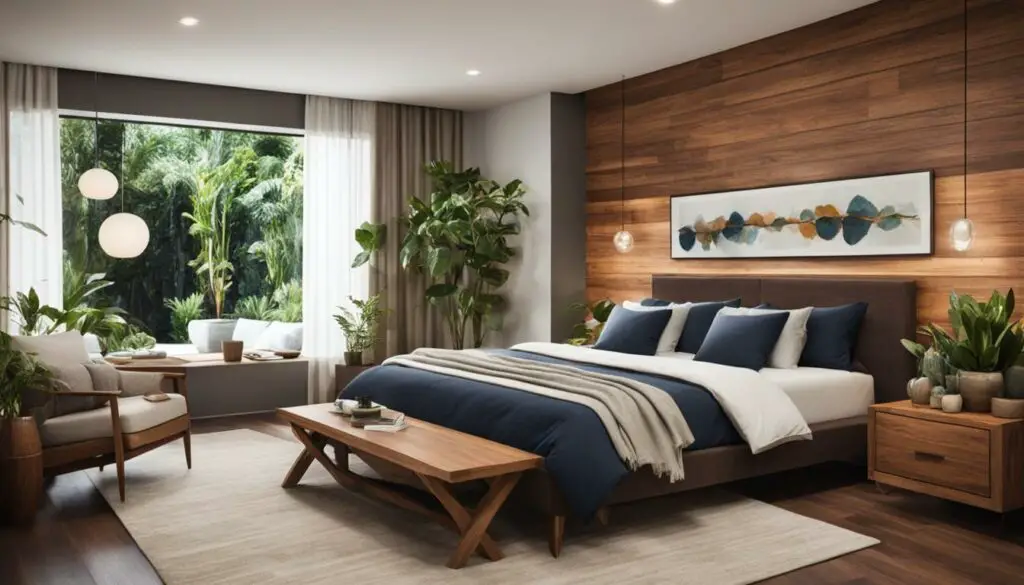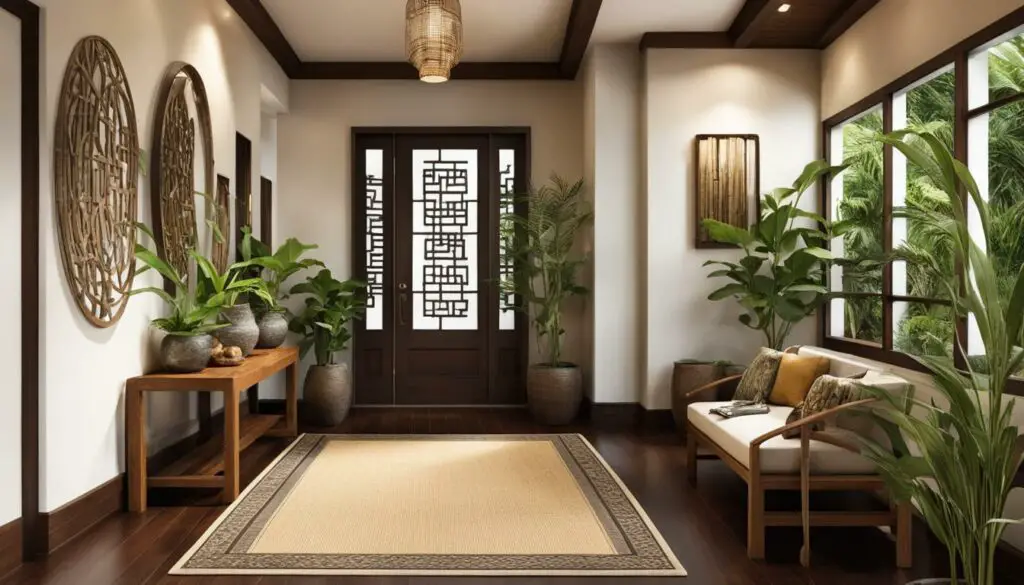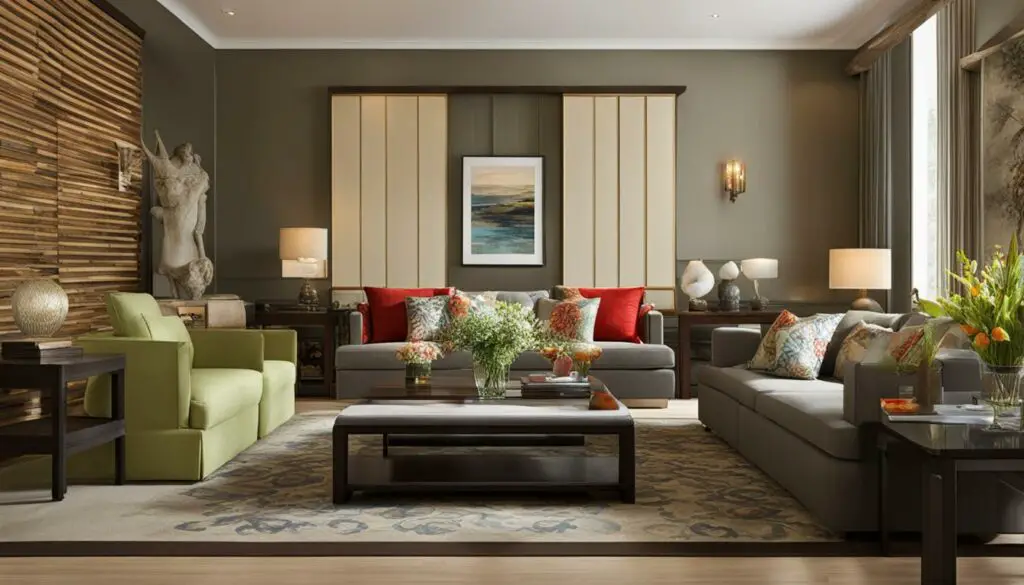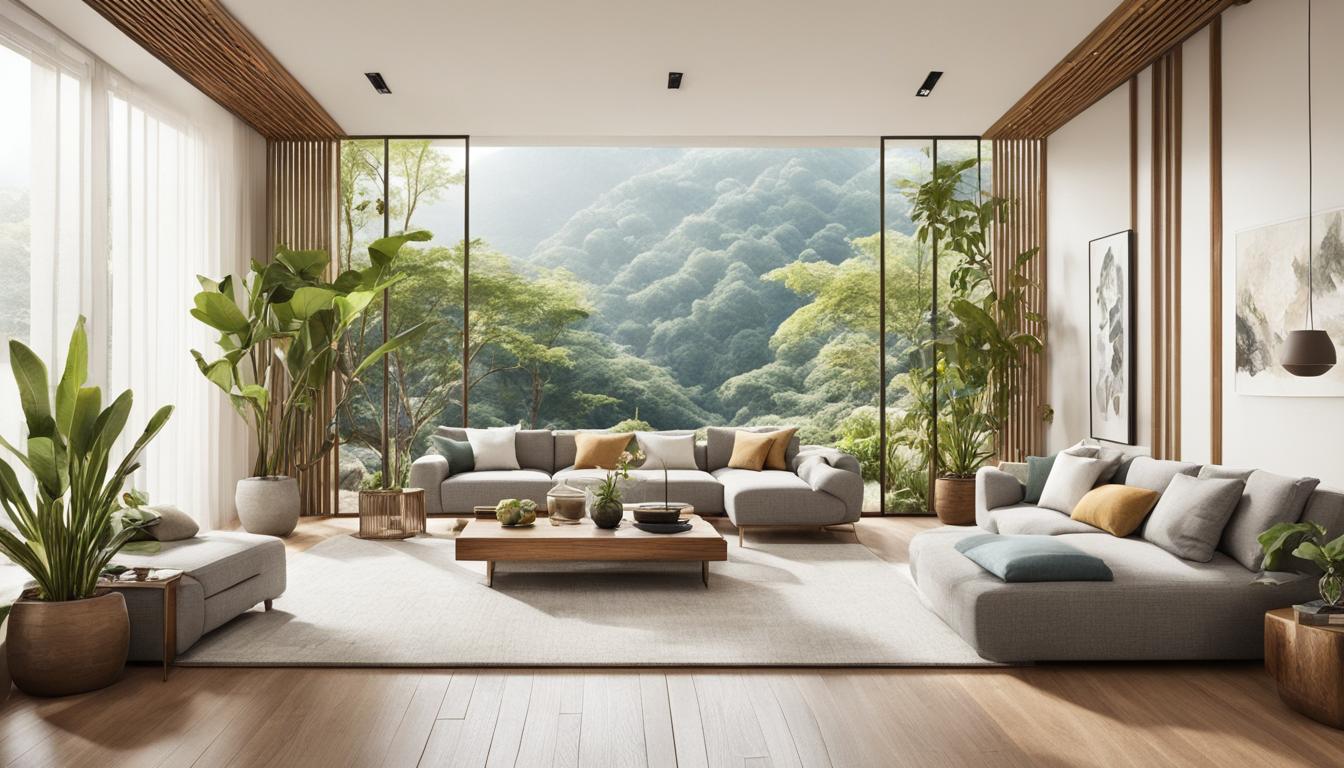Feng Shui, the ancient Chinese art of harmonizing energy in your living space, offers valuable insights into furniture placement and room design. One important aspect of Feng Shui is Kua numbers, also known as Eight Mansions or Eight Houses. These numbers play a significant role in determining auspicious and inauspicious directions for furniture placement based on your birth year and gender.
When it comes to Feng Shui, finding balance is crucial, especially when you have opposing Kua numbers in your household. In this article, we will explore how to effectively balance Feng Shui for opposing Kua numbers, providing you with tips and techniques to bring harmony into your home.
Key Takeaways:
- Understanding Kua numbers is essential for implementing Feng Shui principles in your home.
- Calculate your Kua number using a simple method based on your birth year and gender.
- Furniture placement plays a vital role in promoting positive energy flow based on your auspicious directions.
- Creating a harmonious entryway and using the command position in furniture layout are key techniques in Feng Shui.
- Balance yin and yang energies to bring harmony and vitality to your living space.
Calculating Your Kua Number

Calculating your Kua number is the first step in harnessing the power of Feng Shui for optimal energy flow in your living space. By understanding your Kua number, you can determine your auspicious and inauspicious directions, allowing you to make informed choices regarding furniture placement and room design.
To calculate your Kua number, follow these easy steps:
- Start by adding up the digits of your birth year. For example, if you were born in 1985, the calculation would be 1 + 9 + 8 + 5 = 23.
- Sum the digits of the result until you get a single-digit number. Using our example, 2 + 3 = 5.
- If you are a female, add 5 to that single number. In our example, 5 + 5 = 10.
- If necessary, sum the digits again to achieve a single-digit number. Continuing our example, 1 + 0 = 1.
- If you are a male, subtract the number from 11. In our example, 11 – 5 = 6.
This final number is your Kua number, which will serve as a guide for your Feng Shui practices. With your Kua number in hand, you can now explore the auspicious and inauspicious directions for your specific number and apply this knowledge to create a harmonious environment in your home.
“Your Kua number is the key that unlocks the potential of Feng Shui in your life. By understanding the easy method for calculating your Kua number, you can take charge of your space and attract positive energy.”
Furniture Placement Based on Kua Number

Once you have discovered your Kua number and identified your auspicious and inauspicious directions, you can begin to apply Feng Shui principles to optimize the layout of your bedroom. By strategically arranging your furniture, you can enhance the flow of positive energy and create a harmonious space.
In a Feng Shui bedroom layout, one key element to consider is the positioning of your bed. To promote better energy flow and visibility, it is recommended to place your bed diagonally from the bedroom door. This arrangement allows the chi (energy) to circulate freely around the room, creating a sense of balance and tranquility.
It is important to avoid placing mirrors directly opposite or above the bed, as they can create excessive energy and disrupt sleep. Mirrors are known to reflect and amplify energy, which can be overwhelming in the context of the bedroom. Instead, consider placing mirrors on the side walls or in other areas where they do not directly face the bed.
In Feng Shui, balance is key. To promote harmony in your bedroom, try to keep items in pairs, such as bedside tables, lamps, or decorative objects. This symbolizes the concept of duality and creates a sense of completeness in the space.
Avoid cluttering your bedroom with unnecessary objects, as this can obstruct the flow of energy and create a sense of unease. Keep your bedroom clean, organized, and free of excessive belongings to maintain a serene and peaceful environment.
Remember, the goal of Feng Shui furniture placement in the bedroom is to create a space that promotes relaxation, rejuvenation, and positive energy. By aligning your furniture and taking into account the principles of Feng Shui, you can transform your bedroom into a sanctuary of harmony and balance.
Creating a Harmonious Entryway

The entryway of your home serves as the gateway for positive energy, known as chi, to flow into your space. A well-designed and welcoming entryway sets the tone for the entire home, promoting a sense of harmony and balance. To create an inviting entryway that harnesses the principles of feng shui, consider the following tips:
- Declutter: Start by decluttering the entryway to remove any unnecessary items that may hinder the flow of energy. Keep the space clean and organized, allowing the positive energy to circulate freely.
- Ample Lighting: Ensure that your entryway is well-lit to welcome positive energy. Natural light is ideal, but if that’s not possible, you can use artificial lighting with warm tones to create a cozy and inviting atmosphere.
- Use Mirrors: Mirrors can help expand the entryway’s visual space and reflect positive energy into your home. Place a mirror strategically to amplify natural light and create an illusion of a larger, more open area.
- Introduce Plants: Plants bring life and vibrant energy into any space. Consider adding a small potted plant or beautiful flowers in the entryway to enhance the positive energy and create a fresh and inviting atmosphere.
- Add Meaningful Decorations: Incorporate meaningful decorations, such as artwork, photographs, or symbols, that evoke positive emotions. These decorations not only reflect your personal style but also contribute to the overall positive ambiance of the entryway.
Remember, the goal is to create a harmonious entryway that immediately uplifts and energizes anyone who enters your home. By implementing these feng shui principles, you can create a space that not only welcomes positive energy but also sets a positive tone for the rest of your home.
By following these feng shui entryway design tips and welcoming energy into your home, you can create a space that is not only aesthetically pleasing but also promotes a sense of tranquility and balance from the moment you step through the door.
| Decoration | Meaning |
|---|---|
| A small water fountain or a painting with a water motif | Represents abundance, flow, and wealth |
| A sign or doormat with a positive or welcoming message | Invites positive energy and sets a positive tone |
| A bowl of fresh fruits or a fruit-themed artwork | Symbolizes prosperity and abundance |
| A wind chime or a piece of wind-inspired artwork | Brings movement and positive energy into the entryway |
Using Command Position in Furniture Layout

In Feng Shui, the command position is a principle that allows you to take charge of your space by strategically placing your furniture. By positioning the largest pieces, such as the sofa or bed, in a way that allows you to see the door indirectly, you can create a sense of control and awareness. This optimal furniture layout not only enhances the flow of energy but also prepares you to deal with what’s coming into your life.
Whether it’s in your living room, office, or any other room in your home, applying the command position can bring balance and harmony to your space. By considering the placement of your furniture and ensuring that you have a clear view of the entrance, you can feel empowered and in command of your environment.
When arranging your furniture, keep in mind that the command position ensures that you are in control without feeling overwhelmed. It allows you to maintain a sense of awareness and readiness while embracing positive energy.
“By placing the largest pieces of furniture, such as the sofa, in a position where you can see the door indirectly, you can feel more in control of your space.”
By strategically placing your furniture in the command position, you create a space that enables you to take charge and overcome any challenges. This layout helps you maintain a harmonious balance and maximize the positive energy within your home.
Applying the command position is a simple yet effective way to optimize your furniture layout and achieve a balanced living space. By taking charge of your environment, you can create a sense of empowerment and enhance the overall energy flow in your home.
When it comes to Feng Shui, the command position is a key element in optimizing your furniture layout and taking charge of your space. By strategically placing your furniture to allow for indirect visibility of the door, you can create a harmonious and empowered environment.
Importance of Bathroom, Bedroom, and Kitchen in Feng Shui

According to Feng Shui principles, the bathroom, bedroom, and kitchen are considered the three most vital rooms in a home. Each of these spaces plays a crucial role in promoting positive energy flow and creating a harmonious living environment.
Bathroom Tips
The bathroom is a space where energy can easily drain if not maintained properly. To maintain a positive Feng Shui energy in your bathroom, it is important to follow these tips:
- Keep the bathroom door closed to avoid energy leakage.
- Shut the toilet seat when not in use to prevent energy from being flushed away.
Bedroom Design
The bedroom is a place of rest and rejuvenation, where you spend a significant amount of time each day. To create a harmonious bedroom design that promotes a sense of security and grounding sleep, consider the following tips:
- Position the bed against a solid wall to provide a sense of support and stability.
- Place a sturdy headboard behind the bed to create a strong foundation.
Kitchen Layout
The kitchen is often referred to as the heart of the home and symbolizes wealth, abundance, and health. To maximize the positive energy in your kitchen, follow these Feng Shui principles:
- Keep the kitchen clean, clutter-free, and grease-free to promote a positive flow of energy.
By focusing on these important rooms and implementing Feng Shui principles, you can create a balanced and harmonious living space that promotes positive energy and overall well-being.
Balancing Yin and Yang Energies

In the practice of Feng Shui, the concept of yin and yang plays a crucial role in creating harmony and balance in the home. Yin represents passive, calming energy, while yang represents active, vibrant energy. To achieve optimal Feng Shui, it is important to incorporate both yin and yang elements into your living space.
Incorporating Calm and Active Energy
Creating a harmonious environment involves incorporating elements that promote both calmness and activity. Calm colors such as light blues, soft greens, and muted earth tones can create a serene and relaxed atmosphere. Introduce soothing sounds like flowing water or gentle wind chimes to further enhance the yin energy. Soft lighting, such as warm-toned lamps or candles, can also contribute to a tranquil ambiance.
On the other hand, yang energy can be infused by incorporating bright colors, bold patterns, and lively decor. Vibrant reds, oranges, and yellows can stimulate energy and enthusiasm in your space. Tall plants with upward growth and vibrant blooms can also introduce yang energy. Consider adding artwork, such as abstract paintings or energetic photographs, to infuse your space with active vibrations.
Creating Harmony in the Home
The key to achieving balance is to create a harmonious coexistence between yin and yang energies. By combining these opposing forces, you can achieve a space that is both tranquil and invigorating. A well-balanced yin and yang environment allows for a smooth flow of energy, fostering positivity and well-being.
Remember, while yin and yang energies may seem contradictory, they are complementary and necessary for optimal Feng Shui. Seek to strike a balance in your home by incorporating both calmness and activity, allowing for a harmonious energy flow that promotes a sense of serenity and vitality.
Yin and Yang Elements in Feng Shui
| Yin Energy | Yang Energy |
|---|---|
| Calm colors (light blues, soft greens) | Bright colors (reds, oranges, yellows) |
| Soft lighting (warm-toned lamps, candles) | Lively decor (bold patterns, vibrant artwork) |
| Soothing sounds (flowing water, wind chimes) | Tall plants with upward growth |
Using Feng Shui Directions for Optimal Layout

Feng Shui directions play a crucial role in creating an optimal layout for your living space. By aligning your furniture and important elements with the auspicious directions, you can attract positive energy and enhance the flow throughout your home.
These directions are determined based on compass directions and your birth information. By incorporating them into your furniture placement, you can create a harmonious environment that promotes prosperity, success, good health, love, and personal growth.
Aligning your bed, desk, and other significant furniture with your auspicious directions can greatly impact the energy in your room. Placing your bed in the right direction can enhance your sleep and overall well-being, while positioning your desk in an auspicious direction can boost productivity and focus.
Additionally, arranging other elements of your space, such as mirrors, plants, and decor, according to Feng Shui directions can further amplify positive energy and create a balanced atmosphere.
Here is a table that outlines the auspicious directions for each Kua number:
| Kua Number | Auspicious Directions | Inauspicious Directions |
|---|---|---|
| 1 | South | North |
| 2 | Northeast | Southwest |
| 3 | East | West |
| 4 | Southeast | Northwest |
| 6 | Southwest | Northeast |
| 7 | Northwest | Southeast |
| 8 | West | East |
| 9 | North | South |
By understanding and implementing Feng Shui directions, you can create a space that attracts positive energy, promotes harmony, and aligns with your personal goals and aspirations.
Avoiding Negative Energy with Feng Shui Layouts
To create a harmonious home and avoid negative energy, careful consideration of your floor plan is crucial. By adhering to Feng Shui principles, you can promote positive energy flow and create a balanced living environment.
Here are some tips to help you avoid negative energy in your space:
- Avoid placing bedrooms over the garage: Garages are associated with unsettling energy, so it’s best to keep your bedrooms away from this area.
- Keep bathrooms and storage rooms away from the center of the house: The center of the house represents the heart of the home and should encourage positive energy flow. By relocating bathrooms and storage rooms to other areas, you can maintain a harmonious energy flow throughout your space.
- Avoid dividing the house with a hallway or staircase: Divisions within the household can disrupt the flow of energy. Instead of dividing your house in half with a hallway or staircase, consider alternative layouts that maintain an open and connected flow.
- Ensure a balanced kitchen layout: The stove and sink should not be positioned directly across from each other. This helps maintain a balance of fire and water elements, which are essential for a harmonious kitchen.
By implementing these Feng Shui strategies, you can create a space that avoids negative energy and promotes harmony and positive vibes throughout your home.
Quote:
“A harmonious home begins with a well-designed floor plan that aligns with the principles of Feng Shui.” – Expert Feng Shui Designer
Conclusion
Feng Shui techniques provide a wealth of knowledge and principles to help you create a harmonious and balanced living space. By understanding your Kua number and implementing the guidelines for furniture placement, room design, and energy flow, you can attract positive energy and transform your home into a sanctuary.
One powerful technique is the command position, which allows you to take charge of your space by strategically placing your furniture in a way that gives you a clear view of the room’s entrance. This empowers you to be more in control and aware of what enters your life.
In addition, balancing yin and yang energies is crucial for creating a harmonious environment. Incorporating both calm and active elements, such as soothing colors and lively decor, helps to promote positive energy flow and brings a sense of balance to your space.
To further enhance the positive energy in your home, it’s important to avoid negative energy traps. By carefully considering the layout of your space, avoiding certain placements like bedrooms over garages and ensuring a balance of fire and water elements, you can prevent negative energy from taking hold.
By implementing these Feng Shui techniques, you can harmonize your space and attract positive energy, ultimately creating a sanctuary that supports your well-being and vitality.
FAQ
How do I calculate my Kua number?
To calculate your Kua number, add up the digits of your birth year and make adjustments based on your gender. For females, add 5 to the single-digit result, and for males, subtract the number from 11.
How can I use Feng Shui principles for furniture placement based on my Kua number?
Once you know your Kua number, you can refer to a table to determine your auspicious and inauspicious directions. Use these directions to position your furniture in a way that promotes positive energy flow and balance in your space.
How can I create a harmonious entryway using Feng Shui?
To create a harmonious entryway, keep it clean, clutter-free, and well-lit. Incorporate elements such as plants, mirrors, and meaningful decorations to enhance the energy in this important area of your home.
What is the command position in Feng Shui, and how can I use it in furniture layout?
The command position involves placing the largest pieces of furniture, such as the sofa, in a position where you can see the door indirectly. This layout allows you to feel more in control of your space and be prepared for what comes in. Apply this principle to various rooms in your home for optimal furniture layout.
How can I optimize the bathroom, bedroom, and kitchen in Feng Shui?
Keep the bathroom door closed and the toilet seat shut to prevent energy drain. In the bedroom, use a sturdy headboard and position the bed against a wall for a sense of security and grounding sleep. Keep the kitchen clean, clutter-free, and grease-free to symbolize wealth, abundance, and health.
How can I balance yin and yang energies in my home?
To balance yin and yang energies, incorporate calm colors, soothing sounds, and soft lighting for a yin atmosphere. Bring in bright colors, tall plants, and lively decor for yang energy. Strive to create a harmonious balance between these two energies to promote positive energy flow.
How can I use Feng Shui directions for optimal layout?
Align furniture and important elements of your space with your auspicious directions to enhance the flow of positive energy and attract money, success, good health, love, and personal growth in your life. This can influence the placement of your bed, desk, and other furniture.
How can I avoid negative energy with Feng Shui layouts?
Avoid placing bedrooms over the garage, keeping bathrooms and storage rooms away from the center of the house, and dividing the house in half with a hallway or staircase. Ensure that your stove is not positioned directly across from your sink to maintain a balanced environment.
What are some tips for harmonizing my space with Feng Shui?
By understanding your Kua number and applying Feng Shui principles such as furniture placement, yin and yang balance, and optimal layouts, you can create a harmonious environment that attracts positive energy. These techniques can enhance the flow of vital energy in your home and promote overall well-being.

